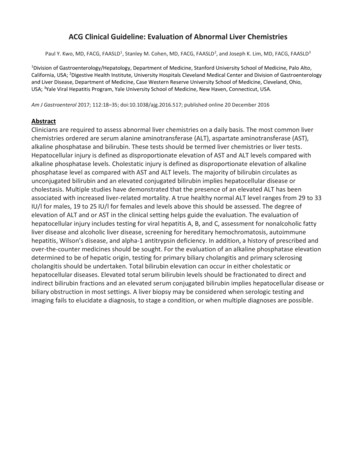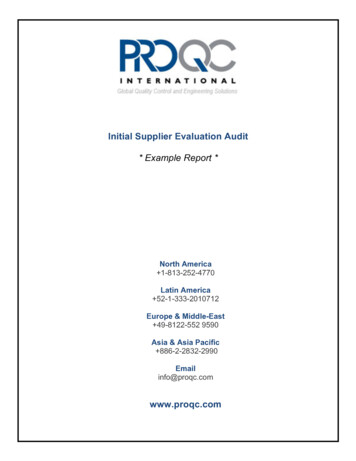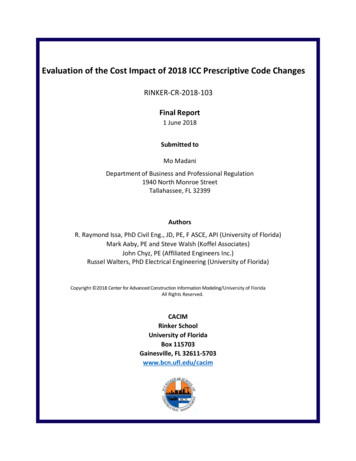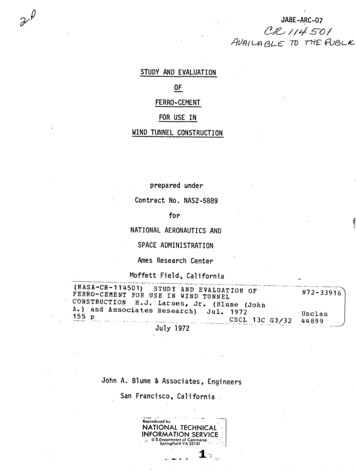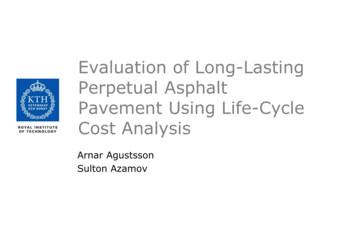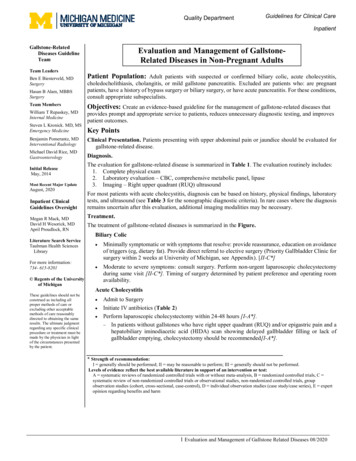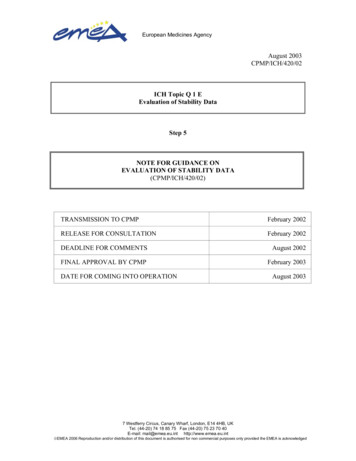
Transcription
European Medicines AgencyAugust 2003CPMP/ICH/420/02ICH Topic Q 1 EEvaluation of Stability DataStep 5NOTE FOR GUIDANCE ONEVALUATION OF STABILITY DATA(CPMP/ICH/420/02)TRANSMISSION TO CPMPFebruary 2002RELEASE FOR CONSULTATIONFebruary 2002DEADLINE FOR COMMENTSAugust 2002FINAL APPROVAL BY CPMPFebruary 2003DATE FOR COMING INTO OPERATION7 Westferry Circus, Canary Wharf, London, E14 4HB, UKTel. (44-20) 74 18 85 75 Fax (44-20) 75 23 70 40E-mail: mail@emea.eu.int http://www.emea.eu.intAugust 2003 EMEA 2006 Reproduction and/or distribution of this document is authorised for non commercial purposes only provided the EMEA is acknowledged
TABLE OF CONTENTS1. INTRODUCTION . 31.1 Objectives of the Guideline . 31.2 Background. 31.3 Scope of the Guideline . 32. GUIDELINES . 32.1 General Principles. 32.2 Data presentation . 52.3 Extrapolation . 52.4 Data Evaluation for Retest Period or Shelf Life Estimation for Drug Substances orProducts Intended for Room Temperature Storage . 52.5 Data Evaluation for Retest Period or Shelf Life Estimation for Drug Substances orProducts Intended for Storage Below Room Temperature. 72.6 General Statistical Approaches. 93. APPENDICES. 9Appendix A: Decision Tree for Data Evaluation for Retest Period or Shelf LifeEstimation for Drug Substances or Products (excluding Frozen Products) . 10Appendix B: EMEA 2006Examples of Statistical Approaches to Stability Data Analysis . 112
EVALUATION OF STABILITY DATA1.INTRODUCTION1.1Objectives of the GuidelineThis guideline is intended to provide recommendations on how to use stability data generatedin accordance with the principles detailed in the ICH guideline “Q1A(R) Stability Testing ofNew Drug Substances and Products” (hereafter referred to as the parent guideline) to proposea retest period or shelf life in a registration application. This guideline describes when andhow extrapolation can be considered when proposing a retest period for a drug substance or ashelf life for a drug product that extends beyond the period covered by “available data fromthe stability study under the long-term storage condition” (hereafter referred to as long-termdata).1.2BackgroundThe guidance on the evaluation and statistical analysis of stability data provided in the parentguideline is brief in nature and limited in scope. The parent guideline states that regressionanalysis is an appropriate approach to analyzing quantitative stability data for retest period orshelf life estimation and recommends that a statistical test for batch poolability be performedusing a level of significance of 0.25. However, the parent guideline includes few details anddoes not cover situations where multiple factors are involved in a full- or reduced-designstudy.This guideline is an expansion of the guidance presented in the Evaluation sections of theparent guideline.1.3Scope of the GuidelineThis guideline addresses the evaluation of stability data that should be submitted inregistration applications for new molecular entities and associated drug products. Theguideline provides recommendations on establishing retest periods and shelf lives for drugsubstances and drug products intended for storage at or below “room temperature”*. It coversstability studies using single- or multi-factor designs and full or reduced designs.*Note: The term “room temperature” refers to the general customary environment and shouldnot be inferred to be the storage statement for labeling.ICH Q6A and Q6B should be consulted for recommendations on the setting and justificationof acceptance criteria, and ICH Q1D should be referenced for recommendations on the use offull- versus reduced-design studies.2.GUIDELINES2.1 General PrinciplesThe design and execution of formal stability studies should follow the principles outlined inthe parent guideline. The purpose of a stability study is to establish, based on testing aminimum of three batches of the drug substance or product, a retest period or shelf life and EMEA 20063
label storage instructions applicable to all future batches manufactured and packaged undersimilar circumstances. The degree of variability of individual batches affects the confidencethat a future production batch will remain within acceptance criteria throughout its retestperiod or shelf life.Although normal manufacturing and analytical variations are to be expected, it is importantthat the drug product be formulated with the intent to provide 100 percent of the labeledamount of the drug substance at the time of batch release. If the assay values of the batchesused to support the registration application are higher than 100 percent of label claim at thetime of batch release, after taking into account manufacturing and analytical variations, theshelf life proposed in the application can be overestimated. On the other hand, if the assayvalue of a batch is lower than 100 percent of label claim at the time of batch release, it mightfall below the lower acceptance criterion before the end of the proposed shelf life.A systematic approach should be adopted in the presentation and evaluation of the stabilityinformation. The stability information should include, as appropriate, results from thephysical, chemical, biological, and microbiological tests, including those related to particularattributes of the dosage form (for example, dissolution rate for solid oral dosage forms). Theadequacy of the mass balance should be assessed. Factors that can cause an apparent lack ofmass balance should be considered, including, for example, the mechanisms of degradationand the stability-indicating capability and inherent variability of the analytical procedures.The basic concepts of stability data evaluation are the same for single- versus multi-factorstudies and for full- versus reduced-design studies. Data from formal stability studies and, asappropriate, supporting data should be evaluated to determine the critical quality attributeslikely to influence the quality and performance of the drug substance or product. Eachattribute should be assessed separately, and an overall assessment should be made of thefindings for the purpose of proposing a retest period or shelf life. The retest period or shelflife proposed should not exceed that predicted for any single attribute.The decision tree in Appendix A outlines a stepwise approach to stability data evaluation andwhen and how much extrapolation can be considered for a proposed retest period or shelf life.Appendix B provides (1) information on how to analyze long-term data for appropriatequantitative test attributes from a study with a multi-factor, full or reduced design, (2)information on how to use regression analysis for retest period or shelf life estimation, and (3)examples of statistical procedures to determine poolability of data from different batches orother factors. Additional guidance can be found in the references listed; however, theexamples and references do not cover all applicable statistical approaches.In general, certain quantitative chemical attributes (e.g., assay, degradation products,preservative content) for a drug substance or product can be assumed to follow zero-orderkinetics during long-term storage1. Data for these attributes are therefore amenable to the typeof statistical analysis described in Appendix B, including linear regression and poolabilitytesting. Although the kinetics of other quantitative attributes (e.g., pH, dissolution) isgenerally not known, the same statistical analysis can be applied, if appropriate. Qualitativeattributes and microbiological attributes are not amenable to this kind of statistical analysis.The recommendations on statistical approaches in this guideline are not intended to imply thatuse of statistical evaluation is preferred when it can be justified to be unnecessary. However,statistical analysis can be useful in supporting the extrapolation of retest periods or shelf livesin certain situations and can be called for to verify the proposed retest periods or shelf lives inother cases. EMEA 20064
2.2Data presentationData for all attributes should be presented in an appropriate format (e.g., tabular, graphical,narrative) and an evaluation of such data should be included in the application. The values ofquantitative attributes at all time points should be reported as measured (e.g., assay as percentof label claim). If a statistical analysis is performed, the procedure used and the assumptionsunderlying the model should be stated and justified. A tabulated summary of the outcome ofstatistical analysis and/or graphical presentation of the long-term data should be included.2.3ExtrapolationExtrapolation is the practice of using a known data set to infer information about future data.Extrapolation to extend the retest period or shelf life beyond the period covered by long-termdata can be proposed in the application, particularly if no significant change is observed at theaccelerated condition. Whether extrapolation of stability data is appropriate depends on theextent of knowledge about the change pattern, the goodness of fit of any mathematical model,and the existence of relevant supporting data. Any extrapolation should be performed suchthat the extended retest period or shelf life will be valid for a future batch released with testresults close to the release acceptance criteria.An extrapolation of stability data assumes that the same change pattern will continue to applybeyond the period covered by long-term data. The correctness of the assumed change patternis critical when extrapolation is considered. When estimating a regression line or curve to fitthe long-term data, the data themselves provide a check on the correctness of the assumedchange pattern, and statistical methods can be applied to test the goodness of fit of the data tothe assumed line or curve. No such internal check is possible beyond the period covered bylong-term data. Thus, a retest period or shelf life granted on the basis of extrapolation shouldalways be verified by additional long-term stability data as soon as these data becomeavailable. Care should be taken to include in the protocol for commitment batches a timepoint that corresponds to the end of the extrapolated retest period or shelf life.2.4Data Evaluation for Retest Period or Shelf Life Estimation for Drug Substancesor Products Intended for Room Temperature StorageA systematic evaluation of the data from formal stability studies should be performed asillustrated in this section. Stability data for each attribute should be assessed sequentially. Fordrug substances or products intended for storage at room temperature, the assessment shouldbegin with any significant change at the accelerated condition and, if appropriate, at theintermediate condition, and progress through the trends and variability of the long-term data.The circumstances are delineated under which extrapolation of retest period or shelf lifebeyond the period covered by long-term data can be appropriate. A decision tree is providedin Appendix A as an aid.2.4.1No significant change at accelerated conditionWhere no significant change occurs at the accelerated condition, the retest period or shelf lifewould depend on the nature of the long-term and accelerated data. EMEA 20065
2.4.1.1Long-term and accelerated data showing little or no change over time and little orno variabilityWhere the long-term data and accelerated data for an attribute show little or no change overtime and little or no variability, it might be apparent that the drug substance or product willremain well within the acceptance criteria for that attribute during the proposed retest periodor shelf life. In these circumstances, a statistical analysis is normally considered unnecessarybut justification for the omission should be provided. Justification can include a discussion ofthe change pattern or lack of change, relevance of the accelerated data, mass balance, and/orother supporting data as described in the parent guideline. Extrapolation of the retest period orshelf life beyond the period covered by long-term data can be proposed. The proposed retestperiod or shelf life can be up to twice, but should not be more than 12 months beyond, theperiod covered by long-term data.2.4.1.2Long-term or accelerated data showing change over time and/or variabilityIf the long-term or accelerated data for an attribute show change over time and/or variabilitywithin a factor or among factors, statistical analysis of the long-term data can be useful inestablishing a retest period or shelf life. Where there are differences in stability observedamong batches or among other factors (e.g., strength, container size and/or fill) or factorcombinations (e.g., strength-by-container size and/or fill) that preclude the combining of data,the proposed retest period or shelf life should not exceed the shortest period supported by anybatch, other factor, or factor combination. Alternatively, where the differences are readilyattributed to a particular factor (e.g., strength), different shelf lives can be assigned todifferent levels within the factor (e.g., different strengths). A discussion should be provided toaddress the cause for the differences and the overall significance of such differences on theproduct. Extrapolation beyond the period covered by long-term data can be proposed;however, the extent of extrapolation would depend on whether long-term data for the attributeare amenable to statistical analysis. Data not amenable to statistical analysisWhere long-term data are not amenable to statistical analysis, but relevant supporting data areprovided, the proposed retest period or shelf life can be up to one-and-a-half times, but shouldnot be more than 6 months beyond, the period covered by long-term data. Relevantsupporting data include satisfactory long-term data from development batches that are (1)made with a closely related formulation to, (2) manufactured on a smaller scale than, or (3)packaged in a container closure system similar to, that of the primary stability batches. Data amenable to statistical analysisIf long-term data are amenable to statistical analysis but no analysis is performed, the extentof extrapolation should be the same as when data are not amenable to statistical analysis.However, if a statistical analysis is performed, it can be appropriate to propose a retest periodor shelf life of up to twice, but not more than 12 months beyond, the period covered by longterm data, when the proposal is backed by the result of the analysis and relevant supportingdata. EMEA 20066
2.4.2Significant change at accelerated conditionWhere significant change* occurs at the accelerated condition, the retest period or shelf lifewould depend on the outcome of stability testing at the intermediate condition, as well as atthe long-term condition.*Note: The following physical changes can be expected to occur at the accelerated conditionand would not be considered significant change that calls for intermediate testing if there is noother significant change:softening of a suppository that is designed to melt at 37ºC, if the melting point is clearlydemonstrated,failure to meet acceptance criteria for dissolution for 12 units of a gelatin capsule or gelcoated tablet if the failure can be unequivocally attributed to cross-linking.However, if phase separation of a semi-solid dosage form occurs at the accelerated condition,testing at the intermediate condition should be performed. Potential interaction effects shouldalso be considered in establishing that there is no other significant change.2.4.2.1No significant change at intermediate conditionIf there is no significant change at the intermediate condition, extrapolation beyond the periodcovered by long-term data can be proposed; however, the extent of extrapolation woulddepend on whether long-term data for the attribute are amenable to statistical analysis. Data not amenable to statistical analysisWhen the long-term data for an attribute are not amenable to statistical analysis, the proposedretest period or shelf life can be up to 3 months beyond the period covered by long-term data,if backed by relevant supporting data. Data amenable to statistical analysisWhen the long-term data for an attribute are amenable to statistical analysis but no analysis isperformed, the extent of extrapolation should be the same as when data are not amenable tostatistical analysis. However, if a statistical analysis is performed, the proposed retest periodor shelf life can be up to one-and-half times, but should not be more than 6 months beyond,the period covered by long-term data, when backed by statistical analysis and relevantsupporting data.2.4.2.2Significant change at intermediate conditionWhere significant change occurs at the intermediate condition, the proposed retest period orshelf life should not exceed the period covered by long-term data. In addition, a retest periodor shelf life shorter than the period covered by long-term data could be called for.2.5Data Evaluation for Retest Period or Shelf Life Estimation for Drug Substancesor Products Intended for Storage Below Room Temperature2.5.1Drug substances or products intended for storage in a refrigeratorData from drug substances or products intended to be stored in a refrigerator should beassessed according to the same principles as described in Section 2.4 for drug substances or EMEA 20067
products intended for room temperature storage, except where explicitly noted in the sectionbelow. The decision tree in Appendix A can be used as an aid.2.5.1.1No significant change at accelerated conditionWhere no significant change occurs at the accelerated condition, extrapolation of retest periodor shelf life beyond the period covered by long-term data can be proposed based on theprinciples outlined in Section 2.4.1, except that the extent of extrapolation should be morelimited.If the long-term and accelerated data show little change over time and little variability, theproposed retest period or shelf life can be up to one-and-a-half times, but should not be morethan 6 months beyond, the period covered by long-term data normally without the support ofstatistical analysis.Where the long-term or accelerated data show change over time and/or variability, theproposed retest period or shelf life can be up to 3 months beyond the period covered by longterm data if (1) the long-term data are amenable to statistical analysis but a statistical analysisis not performed, or (2) the long-term data are not amenable to statistical analysis but relevantsupporting data are provided.Where the long-term or accelerated data show change over time and/or variability, theproposed retest period or shelf life can be up to one-and-a-half times, but should not be morethan 6 months beyond, the
ICH Q6A and Q6B should be consulted for recommendations on the setting and justification of acceptance criteria, and ICH Q1D should be referenced for recommendations on the use of full- versus reduced-design studies. 2. GUIDELINES 2.1 General Principles The design and execution of formal s


